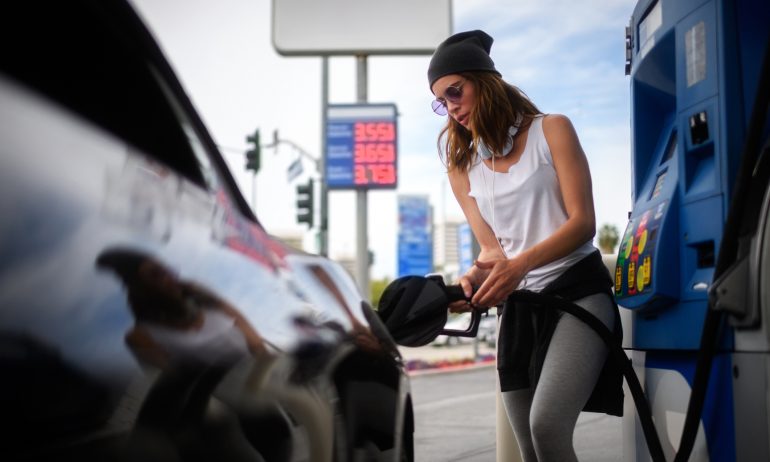Why Did Gas Prices Go Up?

Many or all of the products featured here are from our partners who compensate us. This influences which products we write about and where and how the product appears on a page. However, this does not influence our evaluations. Our opinions are our own. Here is a list of our partners and here's how we make money.
• Updated Sept. 18, 2023, to reflect the most recent average fuel prices in the United States.
Gasoline prices ticked up again in August, according to the latest inflation data from the Bureau of Labor Statistics (BLS).
Gas rose 10.6% from July to August, the BLS’s consumer price index released on Sept. 13 shows. After months of negative or slowed month-over-month growth, gasoline is now the largest contributor to inflation. It accounted for more than half of the increase in August.
Gas prices went up in August for two primary reasons:
Crude oil prices are up largely because both Saudi Arabia and Russia have reduced their production. Both are part of OPEC+, which started cutting supplies of crude oil last year in order to shore up the market. When crude oil costs go up, gas prices do, too.
Oil prices are also higher due to high temperatures over the summer that have made it more difficult for refineries to produce enough gasoline to meet demand.
When gas prices go up, it makes a noticeable difference to consumers. However, gas is still down 3.3% from a year ago. The current month-over-month inflation for gas is now closer to what it was in Nov. 2022. Gas tends to be highly volatile, which is why it’s not considered as a core measure of inflation.
How much does a gallon of gas cost?
The average regular gas price in the U.S. as of Sept. 18 is $3.881 per gallon, according to AAA, which tracks gas prices .
That's slightly higher than last Monday's average price of $3.832 per gallon. It remains higher than many of the fuel prices we've seen this year. After falling for much of the second half of 2022, gas prices this year have mostly ticked up since the spring.
Compared with peak gas prices in recent years, though, the current average represents a roughly 22.4% decline since June 2022, when the average was $5.006 per gallon, according to data from the U.S. Energy Information Administration, or EIA.
When you compare current costs with prices at this time last year — mid September 2022 — a gallon of gas is about $0.20 pricier today, AAA data shows.
What pushes gas prices up?
There are several factors putting upward pressure on gas prices.
Most recently, gas prices spiked in early June 2023 after Saudi Arabia — commonly cited as the world’s biggest oil exporter — said it would slash oil production by at least 1 million barrels per day through July. That cut follows OPEC’s April announcement that it would cut overall oil production by 1.6 million barrels per day.
OPEC, or the Organisation of the Petroleum Exporting Countries, is a syndicate of the world’s largest oil-producing countries that collectively pump roughly 40% of the global crude oil supply, according to the U.S. Energy Information Administration. Its 13 member countries include Saudi Arabia, Iran, Iraq and Nigeria.

Why would Saudi Arabia and OPEC slash production? The answer: to raise the price of oil. By limiting the supply of crude oil in the global marketplace, OPEC can effectively use its monopoly on the world’s oil market to manipulate prices.
OPEC announced on June 4 that it'll extend production cuts by a further 1.4 million barrels per day through the end of 2024.
Gas prices are also rising as China reopens its economy and lifts COVID restrictions. Since 2020, China has enforced some of the world’s strictest lockdown restrictions, and the country only just began re-opening its doors in late 2022. The country’s bounceback has been slowed by logistical hurdles like pricey international flights and visa reinstatement delays. But as the country’s 1.4 billion citizens begin to resume their day-to-day activities, experts predict that’ll translate into higher demand for fuel, which will raise gas prices.
Of course, high inflation affects the price you pay at the pump. And the ongoing war in Ukraine affects fuel prices, too, as the U.S. banned the import of Russian oil following Russia’s invasion of Ukraine. Finally, with summer upon us, increases in things like travel and road trips will naturally increase demand for fuel, thus further raising gas prices.
Who controls gas prices?
No single individual controls gas prices. Instead, the price of gas is determined by a complex set of factors that are at work long before the gas gets to your local station.
Gas prices at the pump rarely reflect that day’s market conditions; instead they represent costs incurred weeks, even months before. That lag makes prices slower to rise and slower to fall than news headlines might suggest. And while spot shortages, refinery production shortages or blending issues can drive up gas prices locally, big, nationwide swings in gas prices are almost always due to the price of crude oil.
The cost of raw crude oil typically represents more than half of the cost of a gallon of gasoline, according to data from the U.S. Energy Information Administration (EIA). Refining, distribution and taxes account for the remainder.
One specific kind of crude oil, West Texas Intermediate crude, is used as the benchmark for oil prices in North America. The price of benchmark West Texas Intermediate crude oil has fallen from more than $115 a barrel in summer 2022 to about $90.77 today, according to the EIA . That's a roughly 21.1% decline. Gasoline prices have declined around 22.4% from their peak at $5.006 per gallon.
Gas prices tend to correlate with consumer sentiment about the overall economy — as gas prices go up, confidence levels with the economic conditions of the country go down, according to research by the Mercatus Center at George Mason University in Virginia .
Put another way, the price of crude oil and the price of gasoline move with supply and demand. Many factors affect both. Recession, pandemic and higher prices tend to tamp down demand; war, collaboration among oil states and tax incentives can limit supply.

What state has the highest gas prices?
California has the highest gas prices, at $5.48 per gallon.
Drivers in the states below are seeing the highest average gas prices per gallon, according to AAA data on Sept. 18:
California: $5.69
Washington: $5.05
Nevada: $4.92
Hawaii: $4.80
Oregon: $4.70
» MORE: Easy ways to save money on gas
What state has the lowest gas prices?
Mississippi has the lowest gas prices, at $3.30 per gallon.
Drivers in the following states are seeing the lowest average gas prices per gallon as of Sept. 18, according to AAA data:
Mississippi: $3.30
Georgia: $3.38
Louisiana: $3.40
Alabama: $3.43
South Carolina: $3.43
» MORE: Best gas credit cards
Types of gas
There are four types of fuel available at the pump that will differ in price. The three non-diesel types of gasoline — regular, midgrade and premium — are categorized by octane rating, a measure of fuel stability (the pressure at which a fuel will combust in an engine).
Regular: The least expensive.
Midgrade or super: More expensive than regular but cheaper than premium and diesel.
Premium or super premium: Most expensive non-diesel gasoline.
The cost of gasoline at your local station depends on multiple costs and profits including :
» MORE: Why is diesel so expensive?
Why are California gas prices so high?
California’s fuel prices are so high for several reasons, including the state’s environmental regulations, taxes and California’s unique self-reliance on refining its own gasoline.
Did you know that the gasoline sold in California is different from gasoline sold anywhere else in the United States? Since the ‘90s, California has mandated that any gasoline sold in the Golden State be produced according to strict guidelines that reduce the gasoline’s overall emissions. As you might expect, California’s cleaner fuel blend is more expensive than the gasoline used by the rest of the nation.
Because of these regulations, more than 90% of gasoline used in California is refined in the state, according to the California Energy Commission. So, if any of the state’s refineries experience unplanned outages or disruptions, those gas prices climb even higher, since the state can’t boost its gasoline supply by importing dirtier fuel that wasn’t refined according to its regulations.
Also, gas prices are high in California because there’s just less gasoline being refined in the state. In late 2022, California mandated that all cars, trucks and SUVs sold in the state be zero-emission vehicles by 2035. Because of that, California’s refining industries are beginning to transition away from fossil fuels, according to The Hoover Institution, a public policy think tank at Stanford University.
Finally, taxes contribute to the state’s sky-high gas prices. Drivers in California pay an estimated $1.19 per gallon in taxes and fees, according to a 2021 study conducted by Stillwater Associates, a transportation consulting firm.
Does the president control gas prices?
The president doesn't set the gas prices you pay at the pump. When prices go up, don’t blame the president. Conversely, when prices go down, don’t thank the president.
The White House is often held responsible for gasoline prices, but the administration rarely has effective tools to move the needle one way or the other. Supply and demand for oil is the culprit.
» MORE: How to choose a gas credit card


